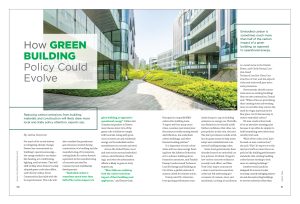How Green Building Policy Could Evolve
Reducing carbon emissions from building materials and construction will likely draw more local and state policy attention, experts say.
For much of its recent history in mitigating climate change, Denver has concentrated on buildings’ operational energy—the energy needed to run basics like heating, air conditioning, lighting, and hot water. That will shift in May, when Denver’s newly adopted green code takes effect, said Christy Collins, Green Communities Specialist with the local government. The code will also consider the greenhouse gas emissions created during construction of a building and the manufacturing of its materials, setting limits for carbon dioxide equivalent in the manufacturing of concrete and steel for commercial and multifamily developments.
“Embodied carbon is sometimes much more than half of the carbon impact of a given building, as opposed to operational energy,” Collins said. Commercial projects in Denver must choose about 10% of the green code to follow to comply with local law. Along with provisions on water use and residential energy are the embodied carbon amendments on concrete and steel.
Across the United States, local and state action around embodied carbon, electrification of buildings, and other decarbonization efforts is likely to grow in 2023, experts say.
“More folks are realizing both the carbon emissions impact of their buildings and appliances,” said Denise Grab, Principal on nonprofit RMI’s carbon-free building team.
“I expect we’ll see many more cities, counties, [and states] over the next year really moving toward electrification, low embodied- carbon buildings, and other forward-looking policies.”
It is important to look at how states will use clean energy funding from the Inflation Reduction Act to advance building decarbonization measures, said Frankie Downy, London-based Technical Lead for Energy and Buildings at C40 Cities, a global network of mayors united for climate action.
Downy said U.S. cities have been passing performance standards that put a cap on building emissions or energy use. The Inflation Reduction Act should instill further confidence that cities can pass policies in this vein, she said. The law’s provisions include $1 billion in grant money to help states adopt new residential and commercial building energy codes.
Some local governments have already focused on embodied carbon policies. Portland, Oregon’s low-carbon concrete ordinance recently took effect, and New York City’s mayor announced a clean construction executive order last fall addressing procurement of cement, steel, and machinery. Looking at machinery is a novel move in the United States, said Cécile Faraud, London-based Technical Lead for Clean Construction at C40, and she expects cities and states will pass more such provisions.
Governments should concentrate more on existing buildings than on new construction, Faraud said. “When cities are prioritizing their existing stock and working more on retrofits, they remove the need for virgin materials in the first place. So it’s the best way to reduce embodied carbon.”
Yet new construction tends to be an attractive starting point because it can often be simpler to build something new rather than retrofit, Grab said.
“Most of the codes so far have focused on new construction,” she said. “But I do expect over the next year we’ll see more focus on policies like building performance standards, like existing building codes that are starting to look more at existing buildings.”
Another trend is policies designed for a more circular economy, namely salvaging materials and deconstructing buildings to recover materials rather than demolishing them. Portland, Oregon and Austin, Texas are some of the cities leading in this area, Faraud said.
In the United States, embodied carbon policy usually emphasizes cement, concrete, and steel, Faraud said. Denver began its own efforts with concrete and steel because their production processes emit large amounts of carbon relative to other building materials. Steel production, for example, is responsible for 6.6% of human-made greenhouse gas emissions globally.
“As we talk about how to develop responsibly, we need density,” Collins said. “But with density comes high-rises. With high-rises come concrete and steel. Concrete and steel are both very impactful materials from an embodied carbon standpoint, so it just makes sense to start talking about them.”
Faraud said there is an opportunity for the United States to use more timber for construction. In addition to timber, Grab said she expects more construction projects to use materials such as straw, hemp, and carbon-sequestering concrete.
In Denver, the city and county will spend the next few years receiving feedback from developers on different provisions in the green code, including those related to embodied carbon, Collins said. The plan is to eventually make policies like this required rather than optional.
“We are bringing these topics forward through the Denver green code to give the development community an opportunity to see that these unfamiliar things are priorities in the Denver community,” she said. “We want to be able to move requirements into mandatory regulations as quickly as we can without causing duress.”
Editor’s Note: For more information on how insulation can help reduce a building’s embodied carbon, visit www.insulation.org/carbon
Adina Solomon is a freelance writer for Construction Dive. This article was first published on Smart Cities Dive on www.constructiondive.com. This article was reprinted with permission from Construction Dive, Copyright 2023. This article was first published on Smart Cities Dive on www.constructiondive.com/news/building-decarbonization-policy-embodied-carbon-green-materials/641364. You can learn more by visiting www.constructiondive.com.

